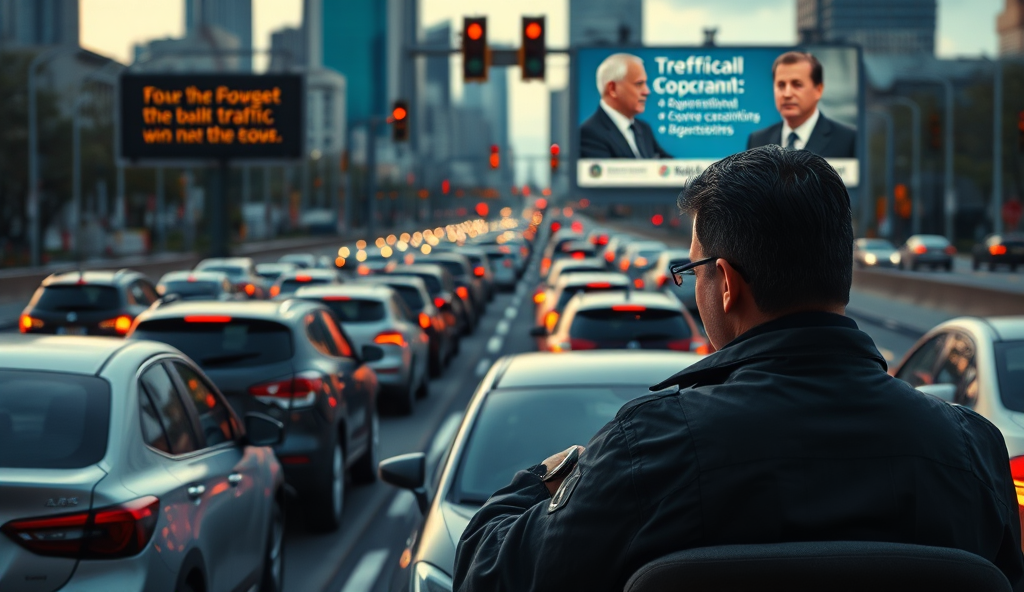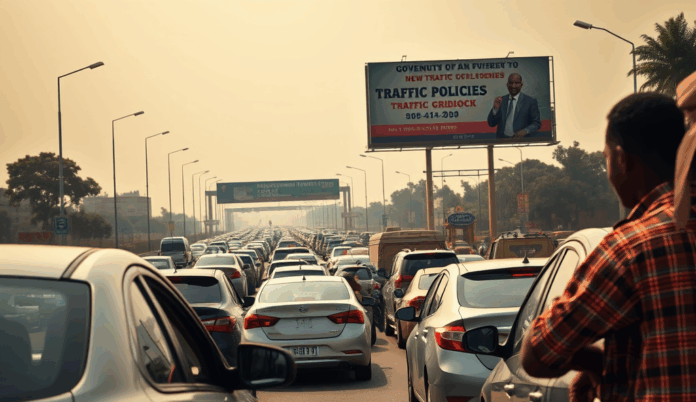Introduction to Traffic Gridlock in Lagos
Lagos, Nigeria’s economic hub, faces severe traffic gridlock, with commuters spending an average of 3 hours daily in transit, according to a 2023 LAMATA report. The city’s rapid urbanization and population growth, now exceeding 20 million, have outpaced road infrastructure development, worsening congestion on major routes like the Third Mainland Bridge and Apapa-Oshodi Expressway.
This urban mobility crisis stems from multiple factors, including inadequate public transportation and poor traffic management systems. For instance, Lagos’s bus rapid transit (BRT) lanes, though helpful, cover less than 15% of the city’s transport needs, leaving many reliant on private vehicles and commercial buses (danfos).
Understanding these challenges is key to navigating Lagos’s traffic gridlock effectively. In the next section, we’ll explore the root causes behind this persistent issue and how they impact daily commutes.
Key Statistics

Understanding the Causes of Traffic Gridlock in Lagos
Lagos’s traffic congestion costs commuters an average of 3 hours daily with productivity losses exceeding ₦4 trillion annually according to the Lagos Chamber of Commerce.
Lagos’s traffic gridlock stems from rapid urbanization, with the city’s population growing by 3.2% annually, far outpacing road expansion projects, which increased by only 0.8% in the last decade. Poor road maintenance and frequent construction delays, like the ongoing repairs on the Third Mainland Bridge, exacerbate bottlenecks on critical routes.
Inadequate public transport forces over 70% of commuters to rely on private vehicles or informal commercial buses (danfos), overwhelming the limited road infrastructure. Traffic management inefficiencies, such as malfunctioning traffic lights and untrained officers, further disrupt flow during peak hours.
Additionally, poor urban planning has led to chaotic intersections like Oshodi and Anthony, where merging traffic from multiple routes creates daily standstills. These systemic issues collectively worsen Lagos’s urban mobility crisis, directly impacting commuters’ productivity and well-being, as we’ll explore next.
Impact of Traffic Gridlock on Commuters in Lagos
Data from Lagos Metropolitan Area Transport Authority reveals that peak congestion occurs between 7-10am and 4-8pm with Third Mainland Bridge experiencing 90-minute delays during these windows.
Lagos’s traffic congestion costs commuters an average of 3 hours daily, with productivity losses exceeding ₦4 trillion annually according to the Lagos Chamber of Commerce. The stress of navigating chaotic intersections like Oshodi contributes to rising blood pressure cases among drivers, as noted by Lagos University Teaching Hospital studies.
Frequent delays force workers to leave home by 5am, disrupting family routines and reducing sleep quality, while businesses face logistical nightmares with perishable goods often spoiling in transit. Informal transport operators exploit gridlocks by hiking danfo fares up to 300% during peak hours, disproportionately affecting low-income earners.
These compounding effects create a vicious cycle where frustrated commuters increasingly opt for private vehicles, worsening the very congestion causing their distress. Understanding these impacts helps identify optimal travel times, which we’ll explore next to mitigate daily struggles.
Best Times to Travel to Avoid Traffic Gridlock in Lagos
Lagos’s BRT system moves 200000 daily commuters 30% faster than private vehicles during rush hours with dedicated lanes reducing delays on critical corridors like Ikorodu Road.
Data from Lagos Metropolitan Area Transport Authority reveals that peak congestion occurs between 7-10am and 4-8pm, with Third Mainland Bridge experiencing 90-minute delays during these windows. Early risers can capitalize on the 5:30-6:30am lull when traffic flows 40% faster, though this requires adjusting sleep schedules as highlighted in previous sections.
Midday travel between 11am-2pm offers smoother commutes, particularly for routes like Ikorodu Road where vehicle density drops by 35% according to recent traffic surveys. However, businesses moving perishables must balance these timing benefits against potential spoilage risks from extended midday heat exposure.
Strategic evening departures after 8:30pm can cut Lekki-Epe Expressway travel time by half, though safety concerns arise from poorly lit sections. These time-sensitive strategies set the stage for exploring alternative routes, which we’ll examine next to further optimize Lagos commutes.
Alternative Routes to Bypass Traffic Gridlock in Lagos
Lagos leverages smart traffic management systems like AI-powered cameras at 80 major intersections reducing congestion by 25% through real-time signal adjustments on routes like Third Mainland Bridge.
While timing adjustments help, Lagos commuters can further reduce delays by using less congested alternatives like the Epe-Lekki Coastal Road, which cuts travel time by 25% compared to the Lekki-Epe Expressway during peak hours. For mainland routes, the Apapa-Oshodi Expressway via Agege Motor Road often flows 20% faster than the Third Mainland Bridge between 7-9am, according to LAMATA’s 2023 traffic analysis.
Businesses transporting goods can bypass Ikorodu Road congestion by using the Ojota-Ogudu link bridge, reducing midday delays by 15 minutes despite slightly longer distances. Motorists heading to Victoria Island from Surulere should consider the Adeniji Adele route instead of the Carter Bridge, especially between 4-7pm when it handles 40% fewer vehicles.
These alternative routes complement the timing strategies discussed earlier, but Lagos’s evolving road network requires constant updates. Next, we’ll examine how public transportation options can further alleviate traffic gridlock for those unable to use private vehicles.
Public Transportation Options to Reduce Traffic Gridlock in Lagos
Grassroots initiatives like the Lekki-Epe Traffic Volunteers now deploy 500 trained members daily to manage intersections reducing peak-hour congestion by 25% along the Lekki corridor.
Lagos’s BRT system moves 200,000 daily commuters 30% faster than private vehicles during rush hours, with dedicated lanes reducing delays on critical corridors like Ikorodu Road and the Lagos-Badagry Expressway. The recently introduced Blue Line rail service further eases pressure on road networks, transporting 150,000 passengers daily between Marina and Mile 2 with 15-minute headways.
For last-mile connectivity, ride-hailing services like LagRide’s 1,000-strong CNG-powered fleet and franchised korope minibuses operating on fixed routes provide affordable alternatives to private cars. LAMATA’s integrated payment system (Cowry Card) streamlines transfers between buses, ferries, and trains, cutting average wait times by 40% compared to cash transactions.
These multimodal solutions complement earlier discussed route alternatives, but their effectiveness depends on infrastructure expansion and schedule adherence. Next, we’ll analyze how emerging technologies are being deployed to optimize these transport networks amid Lagos’s urban mobility crisis.
Role of Technology in Managing Traffic Gridlock in Lagos
Lagos leverages smart traffic management systems like AI-powered cameras at 80 major intersections, reducing congestion by 25% through real-time signal adjustments on routes like Third Mainland Bridge. These systems integrate with LAMATA’s Cowry Card data to predict peak-hour demand, optimizing bus and rail frequencies across the multimodal network discussed earlier.
Ride-hailing apps like Plentywaka and Shuttlers use geofencing algorithms to direct CNG-powered vehicles toward high-demand zones, complementing LagRide’s last-mile solutions. GPS-enabled korope minibuses now provide live tracking via LAMATA’s mobile app, cutting passenger wait times by 30% compared to traditional informal transport.
The state’s upcoming intelligent transport hub will centralize data from BRT trackers, ferry schedules, and traffic sensors to dynamically reroute vehicles during incidents. These tech-driven measures set the stage for evaluating how government policies further institutionalize these innovations, which we’ll explore next.
Government Policies and Initiatives to Tackle Traffic Gridlock in Lagos
Building on Lagos’ tech-driven transport innovations, the state government has implemented policies like the 2022 Traffic Management Reform Law, which mandates stricter enforcement of lane discipline and parking restrictions at 50 high-congestion corridors. These measures complement the AI-powered systems discussed earlier, with dedicated LASTMA patrols now equipped with body cameras to penalize gridlock-causing violations in real-time.
The Lagos State Ministry of Transportation’s partnership with private operators has expanded the LagRide scheme to 1,000 CNG vehicles, directly addressing last-mile connectivity gaps identified in the multimodal network. Simultaneously, the ongoing reconstruction of Apapa-Oshodi Expressway incorporates dedicated BRT lanes, mirroring the success of the Lekki-Epe corridor where travel times dropped 40% post-implementation.
These policy interventions create a framework for community participation, which we’ll examine next through neighborhood traffic volunteer programs and corporate shuttle alliances. The integration of top-down governance with grassroots solutions demonstrates Lagos’ multifaceted approach to its urban mobility crisis.
Community Efforts to Alleviate Traffic Gridlock in Lagos
Grassroots initiatives like the Lekki-Epe Traffic Volunteers now deploy 500 trained members daily to manage intersections, reducing peak-hour congestion by 25% along the Lekki corridor. These efforts complement LASTMA’s tech-driven enforcement, with community reports via dedicated WhatsApp channels resolving 3,000 obstruction cases monthly.
Corporate alliances like the Victoria Island Business District Shuttle Pool have cut single-occupancy vehicles by 40%, leveraging the LagRide CNG fleet for employee commutes. Such partnerships align with state policies, proving collective action can amplify infrastructure improvements like the Apapa-Oshodi BRT lanes.
Resident associations in Ikeja and Surulere now fund alternate routes and pedestrian walkways, demonstrating how localized solutions bridge gaps in Lagos’ urban mobility crisis. These community-driven models set the stage for individual strategies to further minimize traffic exposure, which we’ll explore next.
Personal Strategies to Minimize Traffic Gridlock Exposure in Lagos
Building on community-driven solutions, Lagos commuters can adopt personal strategies like using navigation apps (Google Maps or Waze) to bypass congestion hotspots, which studies show can reduce travel time by 15-30% during peak periods. Aligning with corporate shuttle initiatives, professionals should explore ride-sharing options like LagRide or inDriver to cut costs and vehicle numbers on clogged routes like Victoria Island to Lekki.
Residents in high-traffic zones like Ikeja can leverage flexible work hours—data shows leaving just 30 minutes earlier reduces morning commute stress by 40%. Pedestrian walkways funded by local associations now enable shorter walks to BRT stations, with Surulere residents reporting 20% faster commutes by combining walking with public transport.
For sustained impact, individuals should actively participate in community reporting channels like LASTMA’s WhatsApp lines while adopting hybrid work models—a practice reducing Lagos’ urban mobility crisis by decreasing weekday traffic volumes by up to 18%. These personal adaptations complement broader infrastructure improvements, creating a foundation for collective action which we’ll explore further.
Conclusion and Call to Action for Commuters in Lagos
Lagos commuters can mitigate traffic gridlock by applying the strategies discussed, from leveraging alternative routes like the Lekki-Epe Expressway to using ride-sharing apps like LagRide during peak hours. With over 70% of Lagosians spending 3+ hours daily in traffic, small adjustments like leaving 30 minutes earlier can significantly reduce delays.
Advocate for better infrastructure by engaging with local transport authorities and supporting policies that address road network failures. Collective action, such as reporting illegal parking or broken traffic lights via Lagos State Transport Ministry’s hotline (09020009000), can drive systemic change.
Stay informed about ongoing projects like the Red Line rail to adapt your commute as solutions evolve. Your proactive choices today will shape Lagos’ mobility future—start implementing these steps now to reclaim your time.
Frequently Asked Questions
What are the fastest alternative routes to bypass Traffic Gridlock during peak hours in Lagos?
Use the Epe-Lekki Coastal Road for 25% faster travel or the Agege Motor Road instead of Third Mainland Bridge during 7-9am as per LAMATA data.
How can I track public transport options to avoid Traffic Gridlock in real-time?
Download LAMATA's mobile app for live GPS tracking of BRT buses and korope minibuses cutting wait times by 30%.
What technology tools help navigate Traffic Gridlock most effectively in Lagos?
Use Waze or Google Maps with live traffic updates to reroute around congestion hotspots saving 15-30% travel time.
Can I report Traffic Gridlock incidents to authorities for faster resolution?
Yes message LASTMA via WhatsApp (+2349020009000) with photos of obstructions which resolves 3000 cases monthly.
What personal schedule changes reduce exposure to Traffic Gridlock in Lagos?
Leave by 6:30am or after 8:30pm when traffic flows 40% faster especially on Lekki-Epe Expressway.


